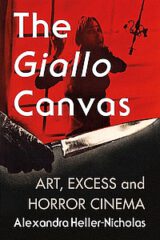The genre of the “yellow” (in Italian: “giallo”) movie, that roughly surfaced in loud colors from the early 1960s, labels generally Italian productions whose plots, as a rule, ended badly for the female protagonists, has attracted many fans worldwide.
 They all appreciate the genre’s blend of tension, thriller elements, usually excellent and highly experimental soundtracks, murderers and villains with sadistic tendencies and violent personalities.
They all appreciate the genre’s blend of tension, thriller elements, usually excellent and highly experimental soundtracks, murderers and villains with sadistic tendencies and violent personalities.
The style’s extraordinary plots, frequently set in Gothic environments and with a unique constellation of characters (orphaned children with secret parentage who grew up to become insane killers, darkest family secrets that must be protected even with murder, often violent assault scenes, set repeatedly within Italian aristocratic circles and crime scenes that take place in ancient mansions and palazzi) clearly sets it apart from the standard (British or American) horror feature.
The “gialli”– a name applied to the genre as an allusion to the cheap pulp novels and crime paperbacks that in Italy were sold in yellow covers were much more refined and took advantage of color film. Many gialli would have been impossible to shoot in the black-and-white film era.
Some dominant features were heavy use of contrasting colors in setting, wardrobe and huge amounts of blood in all variations of red, much advanced movie sound and soundtracks, often using experimental organs and early synthesizer spectacles, good enough for any contemporary psychedelic party, or a rock concert. Apart from excessive violence and extraordinary photography, art itself plays an important role, be it the setting, the insane killer’s desire to copy a murder scene from an ancient etching or the unsuccessful escape of a female victim through halls stuffed with museum-quality sculptures, rugs, and oil paintings in a manor.
Several names will be forever connected with the variety, such as directors Pupi Avati, Luciano Ercoli, Mario Bava, Lucio Fulci, Aldo Lado, Umberto Lenzi, Jesus Franco, and of course maybe the most famous artist of them all, Dario Argento.
Author Heller-Nicholas summons up her early fascination with that particular style of (European) filmmaking, and correctly identifies art (and artful rendering, color composition and by over-doing violence, action and sex in the plot) as major force to get her attention when merely a young fan. “… [T]hese films grabbed me by the throat and wouldn’t let go, regardless – or perhaps precisely because – of how little orthodox ‘sense’ they made. … As I will argue throughout this book, it is this power of art that not just permeates some of the most compelling and memorable giallo films, but in some of its most significant cases, effectively forms its central driving engine.”
Thematic highlights of certain movies are the content of basically the entire first eleven chapters. This follows the standard giallo criticism of several other titles on the genre. The selection of the major themes, however, here is really good. For example, in chapter three, “Girls Asleep, Girls Afraid: Vermeer in The Forbidden Room and The Psychic,” that has the focus on the relation of classic paintings and their meaning for the protagonists, the compositional detail of ancient masters continuously alluded to, where camera and settings echo and determine the victim’s fate, that seems inescapable. Even though being obvious examples of mirroring and incorporating works of art into a giallo plot, those two movies under the microscope here manifest the nature of many other gialli.
As underneath the violence, the blood and tension, there actually is a certain beauty and artistic creation hidden, ready to reveal itself to those who look for it, even if the films are “… often drenched with sex and death …”
Heller-Nicholas, an award-winning Australian film critic who has published several titles on cult, horror and exploitation cinema, closes The Giallo Canvas with what can be understood as, although somewhat short, the highlights of the book. As the final five chapters deal with other peculiarities of the genre, for instance, the representation of fashion and photography in the gialli, in the brief but very good chapter twelve.
Many genre films already integrate dress colors, scarfs and other apparel in their titles, several take place in a fashion industry environment and some productions had their costumes made by famous (Italian) designers. Needless to say that here also the act of dressing/undressing of the female protagonists and the voyeuristic elements are exploited endlessly, accompanied by the respective soundtrack.
The remaining parts mark out the massive use of theatrical settings and obvious allusions to plays and stage (and not movie) performance, and the challenges of defining a category that incorporates all of those attributes.
“In giallo, the style is the substance; this is where it packs its sensorial punch, how it captivates us in ways beyond the orthodox methods’ more traditional mystery-based films have programmed us to. These films demand we privilege the experience of our eyes, ears and other bodily sites of sensory registration over the intellect. …[G]iallo films that engage with art do not just merely invite us to become amateur art historians as much as amateur detectives like so many of the protagonists that haunt the category, but they lure us in, pulling us into their own worlds-of-art themselves.”
A solid title on the giallo films, particularly for those with an interest in art, that inspires further research and collecting.
Review by Dr. A. Ebert © 2021
Alexandra Heller-Nicholas. The Giallo Canvas: Art, Excess and Horror Cinema. McFarland, 2021, 258 p.
